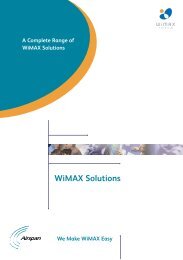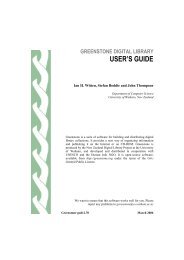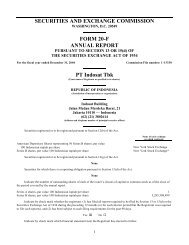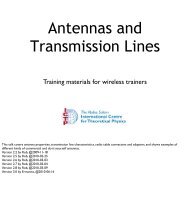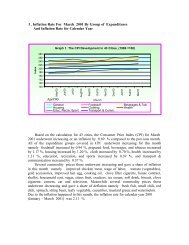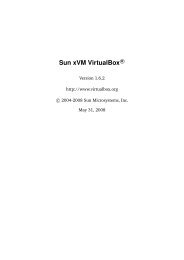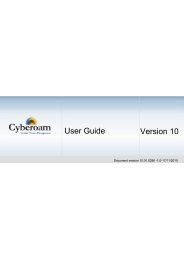K1EL Winkeyer2 v22
K1EL Winkeyer2 v22
K1EL Winkeyer2 v22
You also want an ePaper? Increase the reach of your titles
YUMPU automatically turns print PDFs into web optimized ePapers that Google loves.
<strong>K1EL</strong> <strong>Winkeyer2</strong> CW Keyer for Windows<br />
Bit 6<br />
When this bit is set to one all characters entered on the paddles will be echoed back to the host. From the<br />
host perspective paddle echo and serial echo are the same, in either case the letter sent in Morse by<br />
<strong>Winkeyer2</strong> is echoed back to the host. The echo occurs after the letter has been completely sent. The host<br />
can determine the source by the sense of the “break-in” status bit. If the bit is high when the echoed letter<br />
comes in then the letter’s source was from the paddles, if break-in is low the source if from the serial port.<br />
Bit 5,4<br />
<strong>Winkeyer2</strong> supports Iambic A, B, Ultimatic, and Bug keying modes. In iambic mode <strong>Winkeyer2</strong> makes both<br />
dits and dahs automatically based on which paddle you press. In bug mode <strong>Winkeyer2</strong> makes the dits and<br />
you make the dahs. You also can use bug mode to operate in straight key mode or if you want to key<br />
through <strong>Winkeyer2</strong> with a different keyer, simply set bug mode and use the dah input to key <strong>Winkeyer2</strong>.<br />
In either iambic mode, alternating dits and dahs are sent while both paddles are held closed. In mode B an<br />
extra alternate dit or dah is sent after both paddles are released. In Ultimatic mode when both paddles are<br />
pressed the keyer will send a continuous stream of whichever paddle was last pressed.<br />
Bit 3<br />
Paddle swap: this is a nice feature to have when right and left handed ops want to share the same keyer.<br />
Bit 2<br />
Echo back is a feature that is included to allow a host application to stay exactly in sync with Morse letters<br />
sent. When this mode is enabled all data taken out of the serial buffer is sent to the host after it has been<br />
sent in Morse. This allows the host to reconcile differences in timing introduced by <strong>Winkeyer2</strong>’s internal 32<br />
byte serial buffer. Note that only letters, and not buffered commands with their parameters or wordspaces,<br />
are echoed back to the host.<br />
Bit 1<br />
Here is how autospace works: If you pause for more than one dit time between a dit or dah <strong>Winkeyer2</strong> will<br />
interpret this as a letter-space and will not send the next dit or dah until full letter-space time has been met.<br />
The normal letter-space is 3 dit spaces. <strong>Winkeyer2</strong> has a paddle event memory so that you can enter dits or<br />
dahs during the inter-letter space and <strong>Winkeyer2</strong> will send them as they were entered. With a little practice,<br />
autospace will help you to send near perfect Morse.<br />
Bit 0<br />
<strong>Winkeyer2</strong> supports contest spacing which reduces the wordspace time by one dit. Instead of 7 dits per<br />
wordspace, Contest spacing selects six dits per wordspace.<br />
● Load Defaults value list is a set of 15 binary values<br />
This command is provided to allow all the operating parameters to be loaded into <strong>Winkeyer2</strong> in one block<br />
transfer. The values are binary and must be loaded in order. The values are exactly the same as those<br />
loaded for the individual commands. The preferred time to issue this command is at reset just after the<br />
interface has been opened. Issuing this command while sending Morse is not advised.<br />
1) Mode Register 2) Speed in WPM 3) Sidetone Frequency<br />
4) Weight 5) Lead-In Time 6) Tail Time<br />
7) MinWPM 8) WPM Range 9) 1st Extension<br />
10) Key Compensation 11) Farnsworth WPM 12) Paddle Setpoint<br />
13) Dit/Dah Ratio 14) Pin Configuration 15) Don’t care, set to 0<br />
Figure 13 - Default Value List in order of issuance:<br />
● Set 1 st Extension nn is in the range of (0 to 250) × 1 mSecs<br />
Example: sets lead in to 80 mSecs<br />
<strong>Winkeyer2</strong> addresses a problem often encountered when keying older transceivers that have a slow breakin<br />
response. Due to a slow receive to transmit changeover time, the first dit or dah of a letter sequence can<br />
be chopped and reduced in length. Adding a fixed amount to the first element of a sequence can<br />
compensate for this. For example, an R would be sent with the first dit elongated but the subsequent dah-dit<br />
<strong>Winkeyer2</strong> IC Interface & Operation Manual 6/6/2008 Page 10





